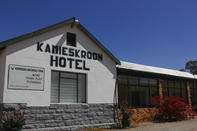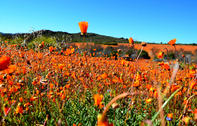Kamiesberg Biome
Once you’ve done your time at Springbok, head south on the N7 and drive for about 68 kilometres until you reach the little town of Kamieskroon. This is the centre of the Kamiesberg biome and offers access to several fascinating destinations. It is also the heart of the newly-developed !Kimmies (‘to gather’) Route, a community-driven tourist initiative. Kamieskroon itself is a rather messy little dorp consisting of about 100 unassuming homes arranged along a rough grid of gravel roads. It’s a dozy, dreamy place and the enveloping mountains seem to cradle the town in a granitic embrace.
Three interesting mountain peaks lend character to the town, namely Kardou (south-east of the town), Boesmankop (asleep on his back on the west side) and Sneeukop (north-east of the town), which at a height of 1591 m is the second highest point in Namaqualand.
In season, the gardens, yards and even the drainage ditches are made beautiful by sprays of wildflowers that poke up carelessly from the ground. In terms of tourist facilities, the town has an attractive church that’s worth a look, a convenience store that sells petrol, and a couple of coffee shops (which may or may not be open when you visit). There is also a caravan park and campsite, and the local hotel offers photographic workshops that will teach you how to take better pics.
Kamieskroon Community

The first settlement in the Kamiesberg began in the 1860s on the farm Wilgenhoutskloof, located in a narrow valley about 8 kilometres north of present-day Kamieskroon. It was soon renamed Bowesdorp, after the local district surgeon Henry Bowe. Apparently, Bowe’s son, Allan, went on to become a partner in the Fabergé jewellery firm - not bad for a country boy.
The Dutch Reformed Congregation chose Bowesdorp as its Namaqualand headquarters in 1870, and a school, hostel, post office, hotel, shops and houses soon grew up around the small church. By 1924, however, the water supply had become insufficient for the growing population and the church was relocated to the nearby village of Kamieskroon. The eerie ruins of Bowesdorp can still be seen, slowly collapsing in their beautiful valley.

